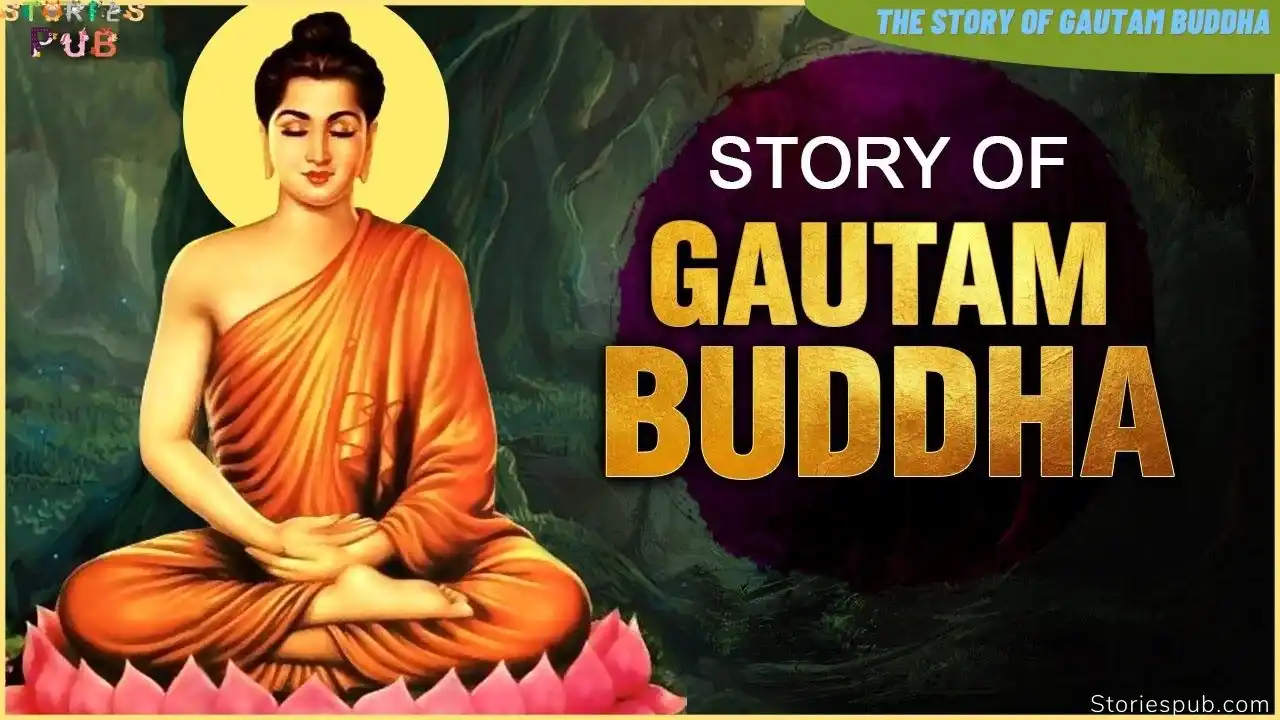From Prince to Buddha: The Story of Gautam Buddha

Gautam Buddha was born as Prince Siddhartha in the Kingdom of Kapilavastu in modern-day Nepal, over 2,500 years ago. He was the son of King Suddhodana and Queen Maya and was raised in luxury and comfort. Even though he grew up in a wealthy family, Siddhartha felt restless and wanted to know what life and suffering were really all about.
Once, Siddhartha was walking in a forest when he came across a swan that had been shot by an arrow. The swan was in pain and unable to fly, and the Buddha approached it with compassion. He gently removed the arrow, healed the wound, and set the swan free.
The swan was grateful for the Buddha’s kindness and decided to follow him, becoming his loyal companion. The Buddha accepted the swan as his friend, and the two of them continued on their journey together.
Also Read Complete Panchatantra Stories
He was married to Yasodhara, and they had a son named Rahula. At the age of 29, Siddhartha decided to leave his palace and venture into the world beyond its walls. He encountered a sick person, an old person, and a dead person, and was deeply moved by the suffering he saw. He then met a wandering ascetic who had renounced worldly life in search of enlightenment. Siddhartha made the decision to leave his wife and son behind and become a wandering ascetic as a result of this encounter.
For several years, Siddhartha practised extreme asceticism, denying himself food and water and exposing himself to the elements. However, despite his efforts, he did not achieve enlightenment. One day, he collapsed from exhaustion and had the realisation that the path to enlightenment could not be achieved through self-denial and suffering.
Siddhartha then accepted food from a village woman and realised that moderation was the key to a healthy and balanced life. He sat under a bodhi tree and vowed not to rise until he had attained enlightenment. After six days of deep meditation, he finally achieved what he had been seeking and became known as the Buddha, the “Awakened
Also Read Hitopadesha Tales
When the Buddha returned to his former life, he was reunited with Yasodhara and Rahula, who had become monastics themselves. People say that the Buddha treated Yasodhara with a lot of respect and that he was close to Rahula, who became one of his most important followers.
The Buddha then set out to share his newfound wisdom with the world. He gave his first sermon in the deer park at Sarnath, where he taught the Four Noble Truths: that life is suffering, that suffering arises from desire and attachment, that it is possible to end suffering, and that the way to end suffering is through the Eightfold Path. The Eightfold Path consists of right understanding, right intention, right speech, right action, right livelihood, right effort, right mindfulness, and right concentration.
Also Read Moral Stories
The Buddha’s teachings attracted many followers, and he soon had a large community of disciples. He taught for the rest of his life, travelling throughout India and sharing his wisdom with all who sought it. He performed many miracles and was loved and revered by all who knew him.
The Buddha’s teachings spread rapidly throughout India and beyond. Today, Buddhism is one of the world’s largest religions, with millions of followers worldwide. The core of the Buddha’s teachings are the Four Noble Truths and the Eightfold Path, which provide a roadmap for ending suffering and attaining enlightenment.
Also Read Akbar Birbal Stories
The Buddha taught that the key to ending suffering is the development of wisdom and compassion. He emphasised the importance of mindfulness and meditation as a means of achieving greater awareness and insight. He encouraged his followers to cultivate a sense of loving kindness towards all beings and to live a life of simplicity and generosity.
The Buddha’s teachings also touched on the nature of reality and the importance of breaking free from ignorance and attachment. He taught that everything is impermanent and constantly changing, and that clinging to things only leads to more suffering. He emphasised the importance of letting go of desires and attachments and cultivating a state of equanimity in the face of both pleasure and pain.
Also Read Mythological Stories
The Buddha’s teachings continue to influence and inspire people to this day. Many people find comfort and guidance in his teachings and strive to live a life in accordance with his principles. The Buddha’s life and teachings are a testament to the power of wisdom, compassion, and the human spirit.
In conclusion, Gautam Buddha is remembered as one of the greatest spiritual leaders in history. His teachings continue to inspire and guide people all over the world, and his legacy lives on, influencing countless generations and giving hope and comfort to those who want to understand the nature of reality and the path to enlightenment.
Buddhism as a religion has evolved over the centuries and has taken on different forms in different regions. However, the core principles of the Buddha’s teachings have remained unchanged. Today, Buddhism is practised in many countries around the world, including India, Sri Lanka, Southeast Asia, and Japan.
Also Read Bedtime Stories
In Buddhist countries, the Buddha is revered as a teacher and a guide, and his teachings are considered to be the path to liberation from suffering. Buddhism is often associated with meditation and mindfulness, and many people turn to Buddhism as a way to find peace and inner harmony.
Buddhism has also had a profound impact on the development of other spiritual and philosophical traditions. What the Buddha said about how things change and how crucial it is to let go of attachments has influenced other religions like Hinduism and Taoism.
The Buddha’s life and teachings continue to inspire and inform people all over the world. Whether one is seeking a path to liberation from suffering or simply a greater understanding of the nature of reality, the Buddha’s teachings offer guidance, wisdom, and hope. Gautam Buddha’s legacy will continue to shine brightly and encourage people to live wise, kind, and peaceful lives for many years to come.
What are the Four Sights of Buddha: old age, sickness, death, and monks?
The Four Sights of the Buddha refer to four events that the Buddha-to-be, Siddhartha, witnessed during his travels outside of the palace walls. These things had a big effect on him and made him decide to give up being a prince and go on a search for wisdom and understanding.
The first sight was old age. Siddhartha encountered an old man who was stooped over, wrinkled, and frail. This sight was a shock to Siddhartha, who had lived a life of comfort and luxury and had never seen the effects of aging. He realised that old age was a universal experience and that all beings, no matter how wealthy or powerful, eventually become old and suffer from the infirmities of old age.
Also Read Arabian Nights Stories
The second sight was sickness. Siddhartha saw a sick man lying on the side of the road, writhing in pain and suffering. This sight further reinforced the inevitability of suffering and the reality that even the strongest and healthiest among us can become sick and suffer.
The third sight was death. Siddhartha saw a funeral procession, with a dead body being carried away on a litter. This sight was a powerful reminder that death is an inevitable part of life and that all beings, no matter how rich or poor, must eventually face death.
The fourth sight was a monk. Siddhartha saw a calm and serene monk who had renounced the material world and was walking with a peaceful demeanor. This sight made a lasting impression on Siddhartha, who realised that it was possible to end suffering and attain peace through spiritual practise and meditation.
Also Read AESOP Fables
These four sights had a profound impact on Siddhartha and led him to abandon his princely life and embark on a quest for understanding and enlightenment. They are a powerful reminder that everyone suffers, that it’s important to look for ways to stop suffering, and that spiritual practise can help people find peace and happiness.
The Famous Buddha and Angulimala Story
Angulimal was a notorious bandit who terrorised the countryside, killing and robbing innocent people. He was known for wearing a garland of human fingers around his neck, which he had taken as trophies from his victims.
Despite his fearsome reputation, the Buddha was not afraid to approach Angulimal and offer him the chance to change his ways. He walked up to the thief while he was on the road, but instead of attacking him, he taught him about the importance of compassion and not hurting other people.
Over time, Angulimal was inspired by the Buddha’s teachings and decided to renounce his violent ways. He became a monk, following the Buddha’s teachings and living a life of peace and compassion. He eventually became one of the Buddha’s most devoted followers and was known for his wisdom and kindness.
Also Read Bible Stories
This story illustrates the transformative power of the Buddha’s teachings and the ability of anyone, no matter how violent or dangerous, to change their ways and find redemption. It also highlights the importance of compassion and non-violence and the power of these values to bring peace and happiness to both individuals and society as a whole.
Spreading the Buddha Religion
After achieving enlightenment, the Buddha spent the rest of his life teaching and spreading his message of compassion, wisdom, and liberation. He went all over northern India, teaching anyone who would listen, no matter where they came from or what caste they were.
The Buddha’s teachings, known as the Dharma, were based on his own experience of suffering and the path to liberation that he had discovered. They were centred around the Four Noble Truths and the Eightfold Path and focused on the importance of mindfulness, compassion, wisdom, and non-attachment.
The Buddha’s teachings were well-received, and he soon gained a large following of disciples, both monastic and lay. In turn, these disciples spread the Buddha’s teachings all over India. They set up monasteries and other places where people could learn and practise the Dharma.
As the Buddhist movement grew, it attracted the support of influential leaders and patrons, who provided financial and political support for the spread of the Dharma. The Buddhist community also produced a lot of literature, art, and buildings, which helped keep the teachings of the Buddha alive and spread them to new generations.
Also Read Tenali Raman Stories
Today, Buddhism is one of the largest and most widespread religions in the world, with millions of followers in countries across Asia, Europe, and the Americas. The teachings of the Buddha continue to inspire people of all backgrounds, and his message of compassion and wisdom remains as relevant today as it was over 2,500 years ago.
Buddha’s famous disciples
The Buddha had many disciples during his lifetime, and his teachings inspired countless individuals to follow the path of enlightenment. Some of the most famous of these disciples include:
- Ananda: Ananda was the Buddha’s cousin and personal attendant and is said to have remembered all of the Buddha’s teachings and sermons. He is remembered for his devotion to the Buddha and his tireless work to spread the Dharma. He is thought to be one of the most important people in early Buddhist history.
- Mahakashyapa: Mahakashyapa was one of the Buddha’s senior disciples and is remembered for his wisdom and spiritual insight. He is also known for his part in the First Buddhist Council, where he helped keep the Buddha’s teachings alive and spread them.
- Sariputta: Sariputta was one of the Buddha’s two chief disciples, along with Moggallana, and is remembered for his deep understanding of the Dharma. He helped spread the teachings of the Buddha and was known for his kindness and wisdom.
- Moggallana: Moggallana was the other of the Buddha’s two chief disciples and is remembered for his supernatural powers and ability to read the minds of others. He was one of the Buddha’s closest friends, and people remember him for how much he cared about the Dharma.
- Anuruddha: Anuruddha was one of the Buddha’s disciples and is remembered for his spiritual powers, including the ability to see the past lives of others. He was known for his wisdom and compassion and was an important figure in early Buddhist history.
These disciples, along with many others, played a critical role in spreading the Buddha’s teachings and establishing the Buddhist community. Their examples of devotion, wisdom, and compassion continue to inspire Buddhists to this day.
Gautam Buddha’s famous quotes
The Buddha’s teachings are filled with wise and profound insights into the nature of reality and the human experience. Here are some of his most famous quotes:
“Happiness does not depend on what you have or who you are.” It solely relies on what you think.
“The secret of health for both mind and body is not to mourn for the past, nor to worry about the future, but to live the present moment wisely and earnestly.”
“The mind is everything; what you think, you become.”
“The past is already gone; the future is not yet here.” “There’s only one moment for you to live, and that is the present moment.”
“You will not be punished for your anger; you will be punished by your anger.”
“The root of suffering is attachment.”
“It is better to conquer yourself than to win a thousand battles.”
“Believe nothing, no matter where you read it or who said it, no matter if I have said it, unless it agrees with your own reason and your own common sense.”
“A man is not called wise because he talks and talks again; but if he is peaceful, loving, and fearless, then he is in truth called wise.”
“The only real failure in life is the failure to try.”
These quotes show how deep and wise the Buddha’s teachings are. They also give valuable insights into the nature of reality, the human experience, and the path to happiness and enlightenment.
How did Gautam Buddha die?
The exact cause of the Buddha’s death is not clear, but it is believed that he passed away at the age of 80 after consuming a meal of contaminated pork. Buddhist tradition says that the Buddha gave his last teachings, which are called the Mahaparinirvana Sutra, before he died and reached final nirvana.
Also Read Biographies
In this final discourse, the Buddha taught about the nature of suffering, the path to liberation, and the impermanence of all things. He also said that his teachings would live on long after he was gone, giving Buddhists guidance and support for many years to come.
After the Buddha’s passing, his disciples gathered to honour his memory and preserve his teachings. The First Buddhist Council was held soon after his death, and the teachings were recited and codified, preserving the Buddha’s legacy for future generations.
Also Read Elephant and the Friends
The Buddha’s passing marked the end of his physical life, but his teachings and legacy continue to inspire and guide Buddhists around the world to this day. Buddhists try to follow the teachings of the Buddha and reach enlightenment in the same way he did. They do this by meditating, being mindful, and developing wisdom and compassion.
Buddhist famous places
- Bodh Gaya, India: This is the site where the Buddha is said to have achieved enlightenment and became the Buddha. The Mahabodhi Temple, which marks the spot where the Buddha sat under the bodhi tree, is one of the most important Buddhist pilgrimage sites in the world.
- Lumbini, Nepal: This is the birthplace of the Buddha and is considered one of the most sacred sites in Buddhism. The birthplace of the Buddha is marked by the temple of Maya Devi, which is surrounded by sacred gardens and monasteries.
- Sarnath, India: This is the site where the Buddha delivered his first sermon, known as the “Dhammacakkappavattana Sutta.” The Dhamek Stupa marks the spot where the Buddha gave this important discourse, and the surrounding monasteries are home to many Buddhist relics and artifacts.
- Kusinara, India: This is the site where the Buddha is said to have passed away or entered into parinirvana. The Ramabhar Stupa marks the place where the Buddha’s body was burned, and the monasteries and temples nearby work to keep his teachings and legacy alive.
- Sravasti, India: This was one of the most important centres of Buddhist learning and activity during the Buddha’s lifetime and was the site of many of his famous teachings and miracles. The Jetavana Monastery and the Ananda Bodhi Tree are among the most significant sites here.
- Shwedagon Pagoda, Yangon, Myanmar: This is one of the most famous and magnificent Buddhist temples in the world and is considered one of the holiest sites in Buddhism. People say that the pagoda holds important Buddhist figures and artifacts, as well as relics of the Buddha.
These are just a few of the many famous places associated with Buddhism and its history. Buddhists think of these places as holy, and people come from all over the world to pay their respects to the Buddha and his teachings.
Buddha’s famous statues
- The Great Buddha of Kamakura, Japan: This is a bronze statue of the Buddha located in Kamakura, Japan, and is one of the most famous and iconic Buddhist statues in the world. It is over 13 metres tall and is thought to be one of the world’s biggest and most impressive bronze Buddha statues outside.
- The Reclining Buddha of Wat Pho, Thailand: This is a massive gold-plated statue of the Buddha in the Wat Pho temple in Bangkok, Thailand. The statue is more than 46 metres long and shows the Buddha lying down in peace.
- The Maitreya Buddha of Tokyo, Japan: This is a bronze statue of the future Buddha, Maitreya, located in the Tokyo National Museum in Japan. The statue is more than 10 metres tall and is thought to be one of the world’s largest bronze statues.
- The Leshan Giant Buddha, China: This is a massive stone statue of the Buddha located near the city of Leshan in China. The statue is over 71 metres tall and is carved into a cliff face, making it one of the largest stone Buddha statues in the world.
- The Shakyamuni Buddha of Sarnath, India: This is a bronze statue of the Buddha located in the Sarnath Museum in India. The statue was made in the 5th century, and it is thought to be one of the oldest and most important pictures of Buddha.
Hey kids, how much did you like From Prince to Buddha: The Story of Gautam Buddha? Please share your view in the comment box. Also, please share this story with your friends on social media so they can also enjoy it, and for more such stories, please bookmark storiespub.com.
Check out other stories that we have:





